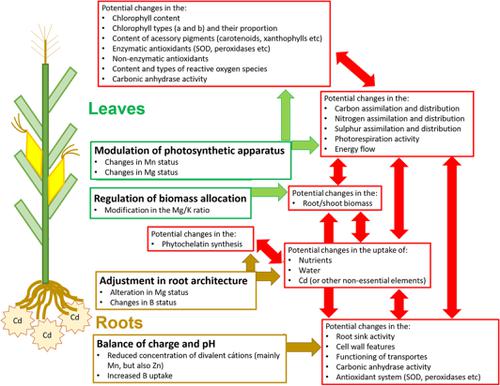当前位置:
X-MOL 学术
›
Ann. Appl. Biol.
›
论文详情
Our official English website, www.x-mol.net, welcomes your feedback! (Note: you will need to create a separate account there.)
The sweet side of misbalanced nutrients in cadmium‐stressed plants
Annals of Applied Biology ( IF 2.6 ) Pub Date : 2020-01-15 , DOI: 10.1111/aab.12569 Marcia E. A. Carvalho 1 , Paulo R. C. Castro 2 , Marcin Kozak 3 , Ricardo A. Azevedo 1
Annals of Applied Biology ( IF 2.6 ) Pub Date : 2020-01-15 , DOI: 10.1111/aab.12569 Marcia E. A. Carvalho 1 , Paulo R. C. Castro 2 , Marcin Kozak 3 , Ricardo A. Azevedo 1
Affiliation

|
Some plants are able to maintain or improve their performance under cadmium (Cd) exposure, despite high Cd concentrations in roots and shoots, indicating that they have protective strategies to neutralise the side effects from Cd accumulation. The regulation of antioxidant machinery and the mitigation of Cd uptake and translocation have been the focus of several studies, but evidence shows that the modulation of nutritional status is also involved in tolerance mechanisms. Although alterations in the nutrient concentrations are usually coupled to negative outcomes on the development of plants under Cd exposure, current works have shown their “sweet” sides. Here, we provide evidence that the degree of plant tolerance to short Cd exposure is, at least partially, associated with differential changes in magnesium (Mg), manganese (Mn) and boron (B) status, all of which modulate physiological and developmental events, such as root architecture (Mg and/or B status), ionomic balance (Mn and/or B status), biomass production (Mg and/or Mn status) and biomass allocation (Mg/K ratio). Modulation of root architecture can be a strategy to obtain water and nutrients in metal‐free patches in a growing medium. Changes in the uptake and/or distribution of nutrients may adjust the ionomic profile to equilibrate charge and pH homeostasis after Cd entrance into the plant. Alterations in the Mn and Mg status may alter the balance between photorespiratory and photosynthetic metabolisms. Finally, reprogramming biomass allocation among organs can be a strategy to remodelling plant body in order to better cope with environmental challenges. The identification and understanding of plant tolerance mechanisms against heavy metal toxicity is necessary to support strategies to mitigate their impacts on crop productivity and quality, supporting food security in increasing environmental contamination in the Anthropocene.
中文翻译:

镉胁迫植物营养失衡的甜蜜一面
尽管根和芽中的Cd浓度很高,但某些植物仍能够在镉(Cd)暴露下保持或改善其性能,这表明它们具有中和Cd积累的副作用的保护性策略。抗氧化剂机制的调节以及Cd吸收和转运的缓解一直是数项研究的重点,但证据表明,营养状态的调节也参与了耐受机制。尽管养分浓度的变化通常与暴露于Cd下的植物的生长产生负面影响,但目前的研究表明它们具有“甜”的一面。在这里,我们提供的证据表明,植物对短时Cd耐受的程度至少部分与镁(Mg)的差异变化有关,锰(B)和锰(Mn)的状态,所有这些都会调节生理和发育事件,例如根系结构(镁和/或硼状态),生物平衡(锰和/或硼状态),生物量生产(镁和/或Mn状态)和生物量分配(Mg / K比)。调节根系结构可以是一种在生长介质中获取无金属斑块中水分和养分的策略。镉进入植物后,养分吸收和/或分布的变化可能会调节蛋白质组学特征,以平衡电荷和pH稳态。锰和镁状态的改变可能会改变光呼吸和光合代谢之间的平衡。最后,重新编程器官之间的生物量分配可以是重塑植物体的策略,以便更好地应对环境挑战。
更新日期:2020-01-15
中文翻译:

镉胁迫植物营养失衡的甜蜜一面
尽管根和芽中的Cd浓度很高,但某些植物仍能够在镉(Cd)暴露下保持或改善其性能,这表明它们具有中和Cd积累的副作用的保护性策略。抗氧化剂机制的调节以及Cd吸收和转运的缓解一直是数项研究的重点,但证据表明,营养状态的调节也参与了耐受机制。尽管养分浓度的变化通常与暴露于Cd下的植物的生长产生负面影响,但目前的研究表明它们具有“甜”的一面。在这里,我们提供的证据表明,植物对短时Cd耐受的程度至少部分与镁(Mg)的差异变化有关,锰(B)和锰(Mn)的状态,所有这些都会调节生理和发育事件,例如根系结构(镁和/或硼状态),生物平衡(锰和/或硼状态),生物量生产(镁和/或Mn状态)和生物量分配(Mg / K比)。调节根系结构可以是一种在生长介质中获取无金属斑块中水分和养分的策略。镉进入植物后,养分吸收和/或分布的变化可能会调节蛋白质组学特征,以平衡电荷和pH稳态。锰和镁状态的改变可能会改变光呼吸和光合代谢之间的平衡。最后,重新编程器官之间的生物量分配可以是重塑植物体的策略,以便更好地应对环境挑战。



























 京公网安备 11010802027423号
京公网安备 11010802027423号